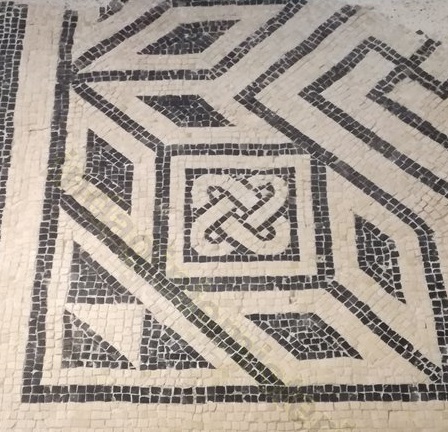Two rings intertwined with each other, a metaphor for an eternal bond before the changing of all things. This is the meaning of Solomon’s knot, a symbol with great expressive power and ancient origins. We find it as a decorative motif in different cultural contexts, in distant worlds ideally connected by its presence. Solomon’s knot has a sacred and evocative name. Among its intricacies of signification it transmits messages, thoughts and truths that are still relevant today.

Solomon’s knot has a multitude of forms: sometimes the ribbons appear soft, like curves of infinite refinement; at other times they unravel into square edges; and at other times they weave into complex and more massive forms. Whatever its depiction, Solomon’s knot arouses astonishment, as a sudden manifestation of a hitherto concealed mystery. The knotted ribbons evoke questions of conscience never really dormant, intellectual gasps about destiny and freedom, about the relationship between man and life to which he is indissolubly bound. The symbol holds deep meanings, universal interrogatives above all cultures, even beyond time and space.

The Celtic origins of Solomon’s knot
Some findings in Camonica Valley attest that Solomon’s knot was already in use among the Celts, a people who loved knot and braid decoration1. Its early symbolic meaning indicated the continuous becoming of the natural elements. The ancients observed the repetition of the cycles of life, such as the alternation of day and night, death and rebirth, good and evil. The Celts conceived of existence on a par with nature, which is constantly regenerating itself.
Solomon’s Knot in Roman period
The symbol later spread throughout Europe as a result of trade in goods and cultural contamination with other peoples. After the Roman conquest of Gaul, Romans used Solomon’s knot. There are numerous depictions of the symbol in mosaic floors from the 1st century AD. We have evidence of it, for example, in the Sanctuary of Minerva at Breno in the province of Brescia, from the Flavian age. Traces of Solomon’s Knot are also at the Domus dell’Ortaglia of Brescia, in Pompeii and in Ostia Antica. For Romans the symbol assumed an apotropaic and auspicious value. Its presence inside dwellings or places of worship ensured the continuation of existence.
The meaning of Solomon’s knot in Christianity
Already in the early centuries Christianity adopted Solomon’s knot. The symbol appeared in the Basilica of San Vitale and the Church of Saint John the Evangelist in Ravenna and in the Patriarchal Basilica of Aquileia.

Solomon’s knot in the Middle Ages
The greatest spread of Solomon’s Knot occurred in the Middle Ages. A number of important religious orders that arose in France in the late 11th century and the first half of the following century used it. Thus, the Cistercian monks and the Knights Templar played a leading role in transmitting the Christian values of the symbol. Therefore, the Solomon’s Knot was depicted on columns and illuminated manuscripts throughout Europe. Likewise, it made its appearance in the Middle East, probably spread by the Crusaders who arrived there to reconquer the Holy Land.

About the name of the Solomon’s Knot
Solomon was the third king of Israel and the Holy Scriptures2 tell of his great deeds, such as the construction of the Temple in Jerusalem3. Here, inside the Holy of Holies, was the Ark of the Covenant, a sacred container and extraordinary relic of Judaism, an absolute symbol of the bond between Yahweh and his people. In fact, it kept the Tablets of the Law received by Moses on Mount Sinai.
Solomon’s wisdom
The Holy Scriptures also report on Solomon’s great wisdom. The Bible tells of two young girls contending over who was the true mother of an infant, before the king. They had become parents almost simultaneously, but one of them had mistakenly smothered her child. She had thus taken possession of the other’s child by deception so well that no one could know the truth. Solomon then decreed to divide the infant in half and give the maidens each a share. One of them, weeping, immediately let the other woman keep the child. In doing so Solomon had revealed the identity of the true mother: she was the one who had preferred to separate from her son rather than see him dead.

The myth of Solomon in the Middle Ages
All these biblical stories contributed to the spread of Solomon myth. During the Middle Ages there was the greatest expression of this epos. In addition, the Knights Templar established their headquarters near the ancient site of Solomon’s Temple in Jerusalem. The building was destroyed at different times, the last time by the Roman general Titus in 70 CE, but this circumstance helped to feed the myth. Solomon was thus the protagonist of many popular tales that attributed unlimited magical powers to him4, among other things.
In the Middle Ages, the figure of the ancient Hebrew king began to be employed as an amulet with an apotropaic function. Indeed, in popular belief it was enough to name him to ward off evil spells and ensure justice. Solomon’s knot was already employed from antiquity for propitiatory and apotropaic purposes, so it was natural to associate it with the figure of the king. In this sense it was a sigillum, seal and guarantee for the good continuation of life.
Samuele Corrente Naso
Notes
- U. Sansoni, Il nodo di Salomone: simbolo e archetipo d’alleanza, Mondadori Electa, 1998. ↩︎
- Many scholars doubt that a reign of Solomon ever really existed, which is placed around the 10th century B.C., having to consider the king’s affairs rather as the tale of a golden, ideal age. ↩︎
- 1, Book of Kings ↩︎
- Gregory of Tours, History of the Franks. ↩︎

